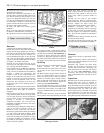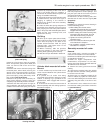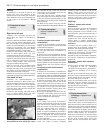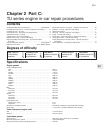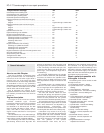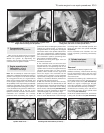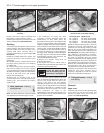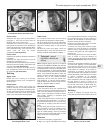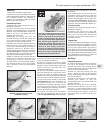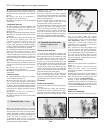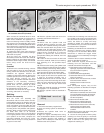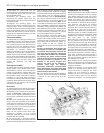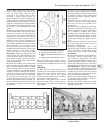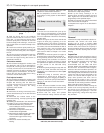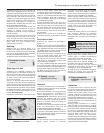
pulley rotates freely, without any sign of
roughness. If necessary, renew the tensioner
pulley as described in Section 8. Make sure
that the locking tools are still in place, as
described in Section 3.
11 Manoeuvre the timing belt into position,
ensuring that the arrows on the belt are
pointing in the direction of rotation (clockwise,
when viewed from the right-hand end of the
engine).
12 Do not twist the timing belt sharply while
refitting it. Fit the belt over the crankshaft and
camshaft sprockets. Make sure that the “front
run” of the belt is taut - ie, ensure that any
slack is on the tensioner pulley side of the belt.
Fit the belt over the coolant pump sprocket
and tensioner pulley. Ensure that the belt teeth
are seated centrally in the sprockets.
13 Loosen the tensioner pulley retaining nut.
Pivot the pulley anti-clockwise to remove all
free play from the timing belt, then retighten
the nut. Tension the timing belt as described
under the relevant sub-heading.
Tensioning without the special
electronic measuring tool
Note: If this method is used, ensure that the
belt tension is checked by a Peugeot dealer at
the earliest possible opportunity.
14 Peugeot dealers use a special tool to
tension the timing belt. A similar tool may be
fabricated using a suitable square-section bar
attached to an arm made from a metal strip; a
hole should be drilled in the strip at a distance
of 80 mm from the centre of the square-
section bar. Fit the tool to the hole in the
tensioner pulley, keeping the tool arm as close
to the horizontal as possible, and hang a 1.5
kg (3.3 lb) weight from the hole in the tool (see
illustration). In the absence of an object of
the specified weight, a spring balance can be
used to exert the required force, ensuring that
the spring balance is held at 90° to the tool
arm. Slacken the pulley retaining nut, allowing
the weight or force exerted (as applicable) to
push the tensioner pulley against the belt,
then retighten the pulley nut.
15 If this special tool is not available, an
approximate setting may be achieved by
pivoting the tensioner pulley anti-clockwise
until it is just possible to twist the timing belt
through 90° by finger and thumb, midway
between the crankshaft and camshaft
sprockets. The deflection of the belt at the
mid-point between the sprockets should be
approximately 6.0 mm.
16 Remove the locking tools from the
camshaft sprocket and flywheel.
17 Using a suitable socket and extension bar
on the crankshaft sprocket bolt, rotate the
crankshaft through four complete rotations in
a clockwise direction (viewed from the right-
hand end of the engine). Do not at any time
rotate the crankshaft anti-clockwise.
18 Slacken the tensioner pulley nut, re-
tension the belt as described in paragraph 14
or 15, then tighten the tensioner pulley nut to
the specified torque.
19 Rotate the crankshaft through a further
two turns clockwise, and check that both the
camshaft sprocket and flywheel timing holes
are still correctly aligned.
20 If all is well, refit the timing belt covers as
described in Section 6, and reconnect the
battery negative lead.
Tensioning using the special
electronic measuring tool
21 Fit the special belt tensioning measuring
equipment to the “front run” of the timing belt,
approximately midway between the camshaft
and crankshaft sprockets. Position the
tensioner pulley so that the belt is tensioned
to a setting of 45 units, then retighten its
retaining nut.
22 Remove the locking tools from the
camshaft sprocket and flywheel, and remove
the measuring tool from the belt.
23 Using a suitable socket and extension bar
on the crankshaft sprocket bolt, rotate the
crankshaft through four complete rotations in
a clockwise direction (viewed from the right-
hand end of the engine). Do not at any time
rotate the crankshaft anti-clockwise.
24 Slacken the tensioner pulley retaining nut,
and refit the measuring tool to the belt. If a
“new” belt is being fitted, tension it to a
setting of 40 units. If an “old” belt is being re-
used, tighten it to a setting of 36 units. Note:
Peugeot state that a belt becomes “old” after
1 hour’s use. With the belt correctly
tensioned, tighten the pulley retaining nut to
the specified torque.
25 Remove the measuring tool from the belt,
then rotate the crankshaft through another
two complete rotations in a clockwise
direction, so that both the camshaft sprocket
and flywheel timing holes are realigned. Do
not at any time rotate the crankshaft anti-
clockwise. Fit the measuring tool to the belt,
and check the belt tension. A “new” belt
should give a reading of 51 ± 3 units; an “old”
belt should be 45 ± 3 units.
26 If the belt tension is incorrect, repeat the
procedures in paragraphs 24 and 25.
27 With the belt tension correctly set, refit the
timing belt covers as described in Section 5,
and reconnect the battery negative lead.
8 Timing belt tensioner and
sprockets - removal,
inspection and refitting
3
Note: This Section describes the removal and
refitting of the components concerned as
individual operations. If more than one of them
is to be removed at the same time, start by
removing the timing belt as described in
Section 7; remove the actual component as
described below, ignoring the preliminary
dismantling steps.
2C•6 TU series engine in-car repair procedures
7.14 Using the Peugeot special tool to tension the timing belt



